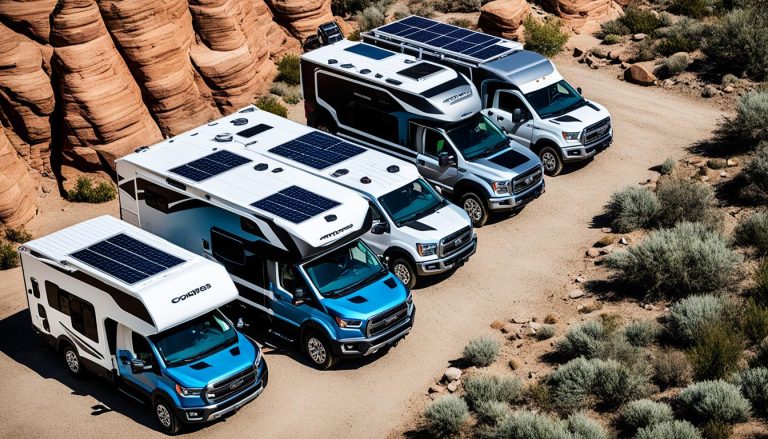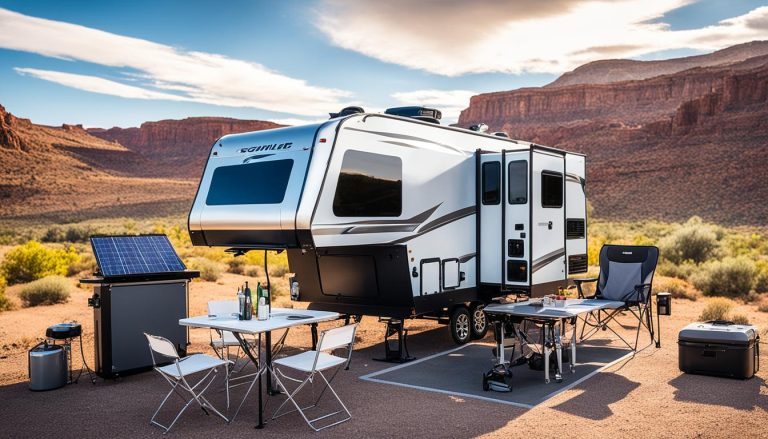Towable RV Safety Tips for Stress-Free Travels
gorvlifestyle.com and its partners may earn a commission if you purchase a product through one of our links
For the adventurer at heart, hitting the open roads with a towable RV brings a unique sense of freedom and joy. However, to truly indulge in stress-free RV travels, one must prioritize towable RV safety. Ensuring a safe journey in your recreational vehicle isn’t just about the destination; it’s about the peace of mind that comes from meticulous preparation and the right safety tips. Whether you’re a seasoned traveler or venturing out with your travel trailer for the first time, understanding and implementing safety measures is paramount to the success of your adventure.
The road beckons, offering sights and experiences only accessible to those brave enough to explore beyond the beaten path. But before the wheels of your home-away-from-home begin to roll, equipping yourself with the necessary knowledge and tools to handle your towable correctly is essential. From the laws of the land to the unspoken rules of the road, we delve into a comprehensive guide to make each mile traveled safe and every moment spent a treasure to remember.
Key Takeaways
- Understanding the importance of towable RV safety for peace of mind on the road.
- Essential safety checks and measures to ensure stress-free RV travels.
- Implementation of safety tips to prevent common travel trailer towing hazards.
- Using the right equipment and knowledge to transform every journey into an unforgettable adventure.
- Ensuring that each trip with your recreational vehicle is both enjoyable and secure.
Understanding the Basics of Towable RV Safety
Embarking on an adventure in your towable RV brings a sense of freedom, but with that comes the responsibility of understanding the critical aspects of Towable RV Safety. Let’s dive into the essential knowledge every traveler should have before hitting the open road. Ensuring the safety of your RV and your passengers hinges on proper techniques in weight distribution, hitching, and maneuvering.
Importance of Weight Distribution
Proper weight distribution is at the forefront of RV towing safety. It is vital to maintain balance across your vehicle’s axles as it affects everything from steering to braking. This prevents the rear end of the towing vehicle from sagging, which can lead to dangerous trailer sway and eventually loss of control. Ensuring that your RV is loaded correctly means a smoother, safer ride.
Essential Hitching Techniques
Equally as important as weight distribution, hitching techniques serve as the foundation of connecting your vehicle to your home away from home. Secure couplers and safety chains are non-negotiable for a steadfast journey. Crossing the safety chains under the hitch ensures that in the event of a disconnection, the trailer is less likely to separate completely, reducing the risk of an accident.
Braking Systems and Trailer Sway Control
Advanced braking systems and trailer sway control mechanisms are modern marvels in the realm of towable RVs. They are central to maintaining consistent behavior of the trailer, enhancing RV towing safety. With these systems in place, the synchronization of vehicle and RV during braking becomes seamless, greatly diminishing the chances of jackknifing or losing control.
| Feature | Function | Benefit |
|---|---|---|
| Weight Distribution System | Evenly spreads load over the axles of the RV | Improves steering and braking; reduces sway |
| Hitching Techniques | Ensures a secure connection between RV and vehicle | Prevents detachment; adds a safety layer in emergencies |
| Trailer Sway Control | Counteracts unwanted lateral movement | Stabilizes RV in heavy winds or sharp turns |
| Integrated Brake Controller | Manages the brake force on the RV wheels | Offers synchronized stopping power; increases safety margin |
Understanding these basics empowers RV enthusiasts with peace of mind. Knowing that you have prepared your rig with the best trailer sway control and braking systems available, coupled with expert knowledge in hitching techniques and weight distribution, you’re ready to embark on your next thrilling but safe RV trip.
Must-Have Towing Gear for a Secure Journey
Embarking on an adventure in your towable RV requires more than just enthusiasm; it necessitates a commitment to safety. Ensuring that your vehicle is equipped with the proper towing gear is not just a recommendation—it’s a necessity for Towable RV Safety. One cannot overstate the importance of a reliable weight distribution hitch, a steadfast sway control system, and an efficient trailer brake controller.
When considering the dynamic nature of towing, these accessories serve as vital components that together create a seamless and secure travel experience. Let’s delve into how each component serves an integral role in your safety checklist.
- A weight distribution hitch plays a pivotal part in stabilizing your load, ensuring that the weight is evenly distributed across both axles of your vehicle. This not only improves steering and braking but also contributes to reducing the dreaded trailer sway.
- Next, a sway control system kicks in to resist side-to-side motion induced by crosswinds or passing trucks. It’s a layer of assurance that keeps your tow in line, even on capricious roadways.
- Completing the holy trinity of towing gear is the trailer brake controller, a device that modulates the trailer’s brake system in synchrony with the towing vehicle. This ensures that both sets of brakes are working in harmony, providing smoother stops and greater control.
While the list of equipment may seem daunting, the resulting peace of mind on the road is priceless. Below is a comparison table detailing these essential pieces of towing gear, each playing an instrumental role in mitigating risks during your RV travels.
| Gear | Function | Benefits |
|---|---|---|
| Weight Distribution Hitch | Equalizes the load across the vehicle’s axles | Better steering and braking, reduced strain on vehicle |
| Sway Control System | Limits trailer movement from side to side | Improved stability in adverse conditions |
| Trailer Brake Controller | Synchronizes trailer and vehicle braking | Smoother stops, decreased risk of jackknifing |
As you gear up for your next outing, remember that investment in proper towing equipment is an investment in your safety and longevity of your recreational vehicle. With the right gear in tow, you can focus on the joys of the journey, confident that you are prepared for what lies ahead.
Finding the Right Balance: 6 Pre-Towing RV Checks
Embarking on an adventure becomes all the more enjoyable when you’ve taken the necessary precautionary steps to ensure safe towing practices. Each of the following RV pre-towing checks serves as a cornerstone in establishing the security and stability of your vessel on the road. By rigorously adhering to these procedures, you’re not just complying with safety standards, but actively contributing to a smoother, safer journey for everyone involved.
Remember, safety is a journey, not a destination.
Evenly Distribute Weight Across the RV
Load balancing is a key factor in maintaining the RV’s handling and stability during travel. Proper distribution of the RV’s weight across its axles curtails the risk of trailer sway, promotes even tire wear, and fortifies the integrity of the vehicle’s structure. By adjusting the load to ensure it’s as centered and low as possible, you’re building the foundation of a secure towing configuration.
Secure Loose Items for Transit
Securing items inside your RV is crucial to prevent mishaps on the road. Objects that are loose or inadequately stowed can shift unexpectedly, potentially causing distraction, injury, or even damaging the interior of your RV during transit. A thorough inspection of the cargo and living areas will confirm that all items are fastened securely before departure.
Safety Chain and Hitch Connection Protocol
The hitch connection and safety chain are quintessential elements to your tow setup. These safeguards work in unison to provide a fail-safe should any part of the primary towing system fail. Following the correct protocol by crossing the chains beneath the hitch and ensuring that the coupler is securely locked onto the hitch ball translates into added security and peace of mind while on the move.
To encapsulate the importance of these procedures, the following table provides an at-a-glance checklist to run through before hitting the open road:
| Check | Description | Importance |
|---|---|---|
| Weight Distribution | Balanced load to minimize trailer sway and ensure stable handling. | High |
| Item Securing | All items within the RV are fastened to prevent movement and potential projectiles. | Essential |
| Hitch & Safety Chains | Inspection of hitch connect and proper placement of safety chains for redundancy. | Critical |
| Break and Light Test | Ensure signals and brake lights are in sync with the towing vehicle. | Vital |
| Tire Inspection | Check for proper tire inflation and wear to prevent blowouts. | Important |
| Battery Charge | Confirm that the RV’s battery is fully charged and operational. | Recommended |
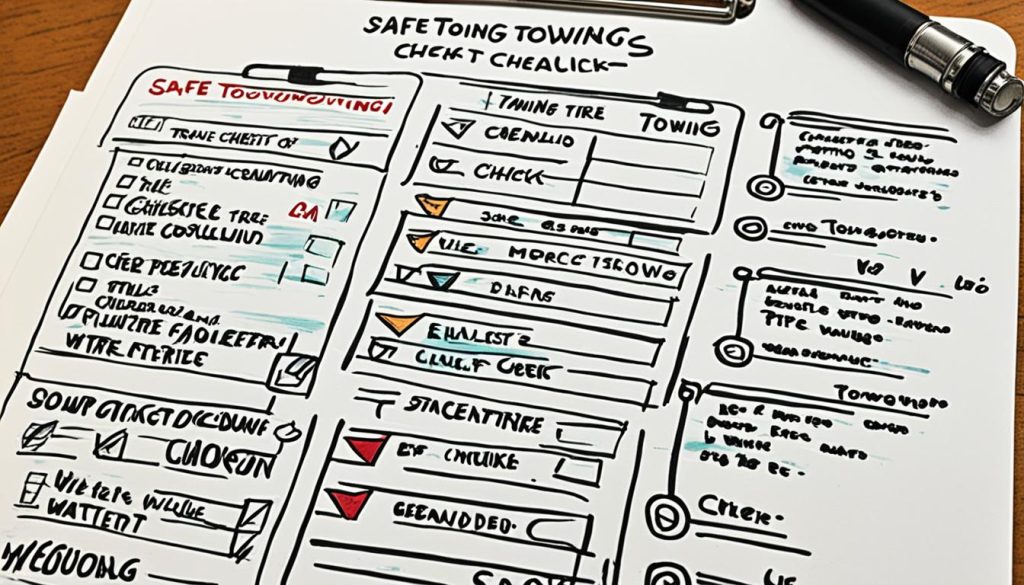
By committing to these RV pre-towing checks, you are not only exercising due diligence but also instilling a culture of safety around RV touring. Such preparation is the invisible yet robust tie that binds you to the seamless and enjoyable travel experiences that await with your home away from home.
Mastering Driving Techniques for Towing an RV
Embarking on an adventure with a trailer in tow is an experience like no other, yet it requires a set of specialized driving techniques to ensure safe RV towing. With the right approach and understanding, anyone can handle backing up, navigate traffic effectively, and adapt to varied weather conditions.
The Art of Backing Up with a Trailer
Backing up a trailer is markedly different from reversing a standard vehicle. It necessitates a firm grasp of the trailer’s pivot points and the counter-intuitive steering required to maneuver it precisely. Strategic use of mirrors becomes crucial for gaining comprehensive visibility around the RV, while slow and steady movements help maintain control during the maneuver. It is paramount for RV hitch safety to ensure that your path is clear of obstacles and that spotters are used if available. Engaging in regular practice sessions in an open area can significantly boost driver confidence.
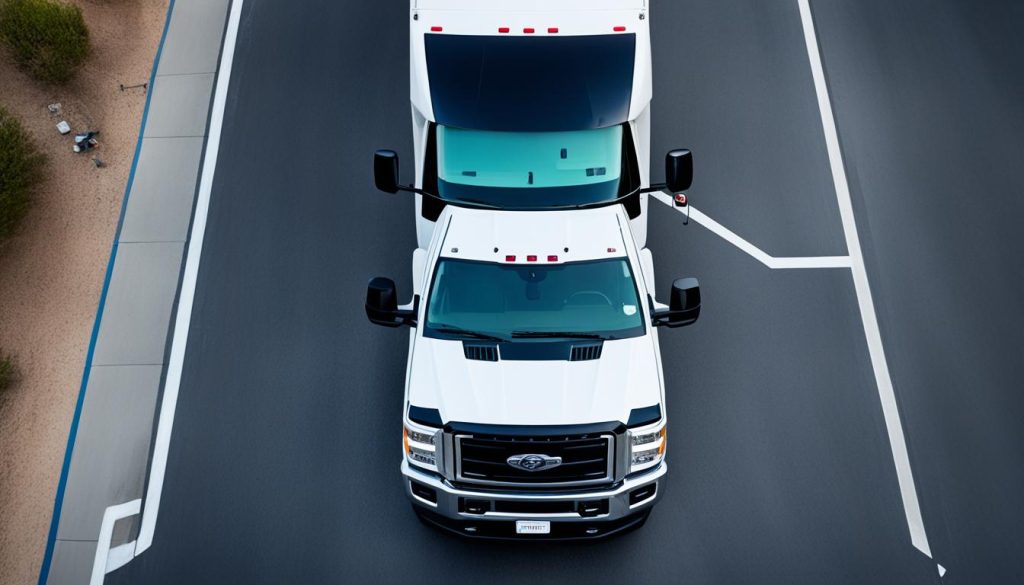
Safe Navigation through Heavy Traffic
Heavy traffic can be stressful when you’re steering a home on wheels. Maintaining an increased following distance is advised to deal with the extended stopping distance of an RV. Being cognizant of your RV’s larger blind spots enables safer lane changes and merges. Also, employing defensive driving techniques can be a safeguard against the unpredictability of navigating traffic. Remember to signal intentions early and monitor the traffic flow to anticipate the actions of other drivers effectively.
Adapting to Weather and Terrain While on the Road
RV travel is not immune to the whims of Mother Nature. Whether it’s rain, snow, or wind, weather adaptation is critical for safe towing. Reducing speed in poor weather conditions, making use of advanced weather alert systems, and ensuring your towing gear is weather-appropriate will enhance your journey’s safety. When faced with challenging terrain, such as steep inclines or rough roads, it’s important to respect the capabilities of your vehicle to prevent overtaxing the engine or brakes.
- Slow down to prevent hydroplaning on wet roads.
- Keep a firm grip on the wheel in windy scenarios to maintain control.
- Increase the braking distance on snowy or icy roads.
Mastering these imperative driving techniques not only upholds RV hitch safety principles but also contributes to peace of mind throughout your excursions. Practicing the refined skills of backing up, vigilant traffic navigation, and proactive weather adaptation will make sure your travels are as secure as they are memorable.
Invest in Regular Maintenance to Prolong RV Life
Embracing a consistent RV maintenance routine not only boosts the performance of your recreational vehicle but is also essential for RV life prolongation. A meticulously conducted RV exterior inspection safeguards against the natural wear and tear that can escalate into expensive repairs down the line. Likewise, a thorough electrical system check ensures all critical features are functioning correctly—keeping your home-on-wheels safe and reliable. Paying attention to weight distribution hitch care is equally important for maintaining balance and stability during your travels.
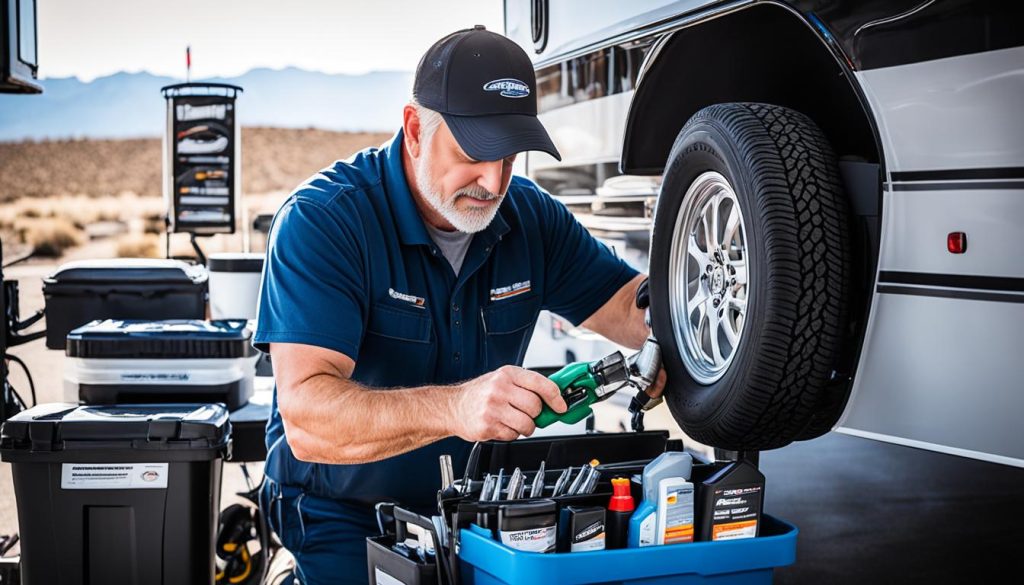
- Monthly RV Exterior Inspection: Check the condition of the roof, seals, and undercarriage.
- Quarterly Electrical System Check: Test batteries, lights, and appliances for proper operation.
- Pre- and Post-Trip Weight Distribution Hitch Care: Clean, lubricate, and check bolt torque consistently.
| Maintenance Activity | Frequency | Benefits |
|---|---|---|
| Roof Sealant Inspection | Bi-annually | Prevents leaks and water damage |
| Tire Pressure and Tread Check | Monthly | Ensures safe traction and fuel efficiency |
| Battery Voltage and Fluid Levels | Quarterly | Avoids power interruptions and battery wear |
| Lights and Signal Functionality | Before each trip | Maintains visibility and communication on the road |
| Appliance Operational Check | Seasonally | Identifies issues before they become major problems |
| Weight Distribution Hitch Examination | Before and after long trips | Ensures optimal towing stability |
By instituting these maintenance measures, you not only preserve the functionality and safety of your RV but also ensure that every journey you embark on is accompanied by peace of mind—a truly invaluable component of any RV adventure.
The Essential Guide to RV Towing Laws and Regulations
Whether you’re a seasoned RVer or just starting out, understanding the RV towing laws and towing regulations is critical to ensure you’re compliant on open roads. Given the diversity of rules that vary from state to state, it’s imperative to familiarize yourself with the intricacies of cross-state towing to ensure a hassle-free adventure.
Adhering to State-Specific Speed and Weight Limits
Navigating through different states means encountering various state-specific speed limits and weight limits. These restrictions not only ensure road safety but are also designed to preserve highway infrastructure. Overlooking these can result in penalties, which can easily dampen the spirit of your travels.
Ensuring RV and Towing Gear Meet Legal Requirements
Compliance is key when it comes to ensuring your RV and towing gear meet legal requirements. This includes regular checks on equipment such as brakes, lights, and hitch systems to certify they are in line with the legal standards of the states you’ll be visiting.
Navigating Different State Towing Laws Across the U.S.
Mastering the rules for cross-state towing is just as important as understanding the equipment on your RV. Here’s a useful resource to keep you informed about the different towing regulations throughout the U.S.
| State | Max Towing Speed | Max Trailer Width | Trailer Brakes Required | Breakaway Switch Required |
|---|---|---|---|---|
| California | 55 mph | 102″ | Yes, if over 1,500 lbs | Yes, if over 3,000 lbs |
| Texas | 60 mph | 102″ | Yes, if over 4,500 lbs | Yes, if over 4,500 lbs |
| New York | 55 mph | 96″ | Yes, if over 1,000 lbs | Yes, if over 3,000 lbs |
| Florida | 65 mph | 102″ | Yes, if over 3,000 lbs | No statutory requirement |
RV Hitch Safety: Connecting Your Home on Wheels
Ensuring RV hitch safety is crucial before embarking on any journey. It requires a keen eye for detail and an informed approach to avoid common pitfalls. With each trip, adventurers should strive to cement their understanding of essential safety protocols to keep their travels smooth and secure.
Inspecting Hitch Equipment Before Departure
Thorough hitch equipment inspection is one of the first steps toward a safe towing experience. This involves checking for any signs of wear, corrosion, or damage that could compromise the integrity of your hitch setup. By doing so, you can address issues before they become hazardous on the road.
Understanding the Capabilities of Your Towing Vehicle
The backbone of safe towing lies in the understanding and respecting your towing vehicle’s capabilities. Being mindful of the vehicle’s towing capacity ensures that your towing vehicle capabilities are not exceeded, preventing the risks that come with overstressing the vehicle’s engine, transmission, and brakes.
| Towing Vehicle Model | Towing Capacity | Recommended RV Weight |
|---|---|---|
| Ford F-150 | 5,000-8,000 lbs | Up to 6,000 lbs |
| Chevrolet Silverado 1500 | 7,000-9,400 lbs | Up to 7,000 lbs |
| Ram 1500 | 6,280-7,730 lbs | Up to 6,000 lbs |
Avoiding Common Mistakes in Hitch Setup
Even experienced travelers can occasionally fall prey to hitch setup mistakes. Issues like an improperly adjusted hitch height, not securing attachments, or overlooking the tension in sway control systems can set the stage for unpredictable handling and potential accidents. Awareness and correct application of hitching procedures are essential for a steadfast connection to your home on wheels.
- Ensure the hitch is level with the RV for optimal weight distribution.
- Regularly check and tighten bolts to prevent wobbling or detachment.
- Adjust sway control devices in accordance with the load and road conditions.
Safe Towing Practices: Keeping Calm on the Open Road
Embarking on an excursion with a recreational vehicle offers the allure of adventure and the promise of memories to be made. As one navigates the highways and byways, adherence to safe towing practices ensures that these experiences remain idyllic and serene. The foundation of a stress-free RV travel lies in the adeptness of defensive driving, particularly when towing a sizeable travel trailer. By maintaining a cushion of space on the road, you not only protect yourself and your passengers but also grant yourself the much-needed time to react to the dynamic road conditions.
Maintaining a Defensive Driving Position
Defensive driving extends beyond your immediate vicinity on the road. It’s about being vigilant and anticipating the actions of other drivers and potential hazards. Safe towing practices, such as scanning far ahead and maintaining a defensive position, allow for ample stopping distance — a critical necessity when hauling a heavier load. Adjusting to the flow of traffic while giving yourself adequate room to maneuver, can make a remarkable difference in your towing experience, ensuring safety is at the forefront of your journey.
Handling Unexpected Road Situations with Confidence
The open road can often present unexpected road situations that necessitate prompt and calm reactions. Inclement weather, road closures, and detours are but a few of the challenges that can arise. A thorough understanding of your RV’s handling capabilities ensures that when faced with such scenarios, your response is one of confidence and control. By anticipating these conditions and adjusting your driving accordingly, you navigate through the unpredictable with poise, keeping your on-the-road adventure safe and enjoyable.
Learning the Limits of Your RV and Tow Vehicle
Lastly, appreciating and respecting the limits of your RV and tow vehicle is paramount. Each vehicle has its own specifications for weight, speed, and performance that must be observed for optimal safety. Overburden your vehicle or push it beyond its engineered capacity, and you invite undue risk. By staying within these limits and regularly checking that all components of your towing setup are functioning correctly, you take proactive steps toward preventing incidents, safeguarding your journey against potential accidents that could disrupt your travel. In essence, when you know your limits, you maximize not just your vehicle’s efficiency, but also your peace of mind while exploring the great outdoors.


